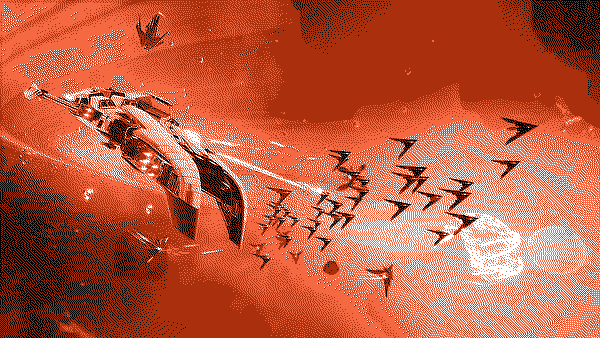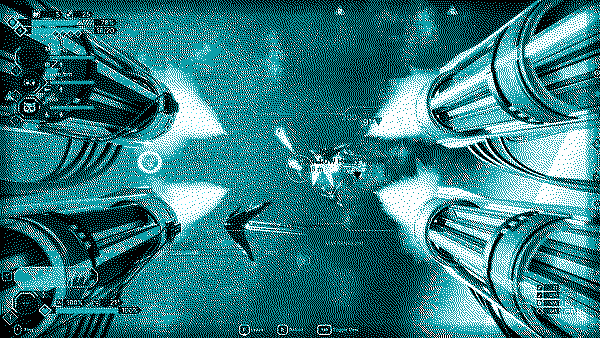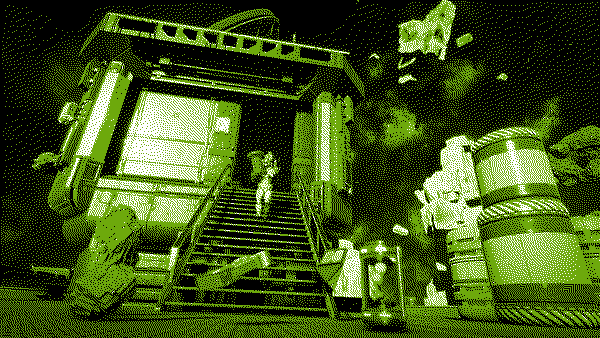Void Crew
A comforting expanse of void space

I’ve been playing some Void Crew co-operatively on my docked Steamdeck using a Dualsense controller and a pair of bluetooth microphone earbuds for comms.
It’s a game that bewilders at first, as you are thrown into the deep end of understanding the means and mechanics of a running a starship, from powering it, to piloting it and making sure it has the appropriate subsystems (offensive weapon types - beam and kinetic, cargo trawling hooks, defensive shielding, point defense weapons and power generator capacity).
Coupled with your ship selection, loadout and personal skillset as a powersuited spacefarer, you’ll need to navigate through a nodal roguelite procedurally generated path through the safety of void space, dropping out at mission nodes along the way to eliminate the enemy presence whilst scooping up what equipment you can, data slates and nano alloys so they can be synthesized into new kit or provide the resources to repair your ship and be ready for the next node jump out of the void.
It’s all very compelling and episodic in nature, but your escapades will take their toll on your ship and the crew with each excursion.
It takes a while to become dextrously and technically comfortable with the systems in play and you’ll have to choke down the learning curve of a few obliterations along the way. But, as you gain experience and expertise in the vital roles required, you’ll earn your stripes run by run to become a grizzled vet of scavenging and space conflict.
Fit your crew to the ship
Ignorantly, starting the journey in a 3 to 4 person Destroyer will baffle you with multi-deck mazes in a craft that is too loose a fit for an enthusiastic duo. I do not recommend it, its even a baptism of fire compared with the more modest but nimble frigate.
Utimately, the chaos simulation presented here, requires your crew to adopt complementary roles to survive together. In a duo, you’ll need someone who can pilot and navigate the void lanes, as well someone who is a deft gunner and away team lead to perform the EVA (ExtraVehicular Activity) tasks. This is the minimum.
Many missions will need this combo of accurate ship handling, especially during evasive combat, as well as swift and accurate tactical fire on the shifting waves of the enemy swarm that are incoming.
As you drop out of the void, during the calm of undetected stealth running, you’ll need that EVA specialist who can gravboot walk the outer hull and patch it up with plating, before the next mission.
During a mission that same EVA specialist may be required to jetpack over to an asteroid based station, repair the power conduits and fire up a relay signal so strong it will draw the enemy freighters in for a “smash and grab” ambush.
The rather sedentary pilot will take care of insertion and exfiltration of the away team, in addition to grav scooping any space lobbed cargo. Precise positioning is required to align the position of the scoop on your vessel with the floating valuables in space. The physical placement of your external interacting stations (Guns, Scoops and others) is worth planning out so your pilot can perform spatial alignment, but also your gunner can cover all the firing arcs needed.
In the duo.
One to move the ship.
One to move offship and perform salvage or sabotage duties.
Then both are needed to orchestrate the reunion back in time for swift positioning and broadside gunnery, power managed beam weapon pew pew, to thin the enemy and get the ship ready to warp out to the safety of the void!

From experience, putting the ship in cruise during combat and trying to have a two person gunnery setup, often leads to trouble, taking more damage than you can give. Whereas skilled manoeuvering can save the ship a lot of hull damage in between missions.
Surgical engagement seems to be the trick.
Only light them up when you have your objective in sight and you can deal with what comes along.
Or you have an exit route long enough to spin up a void jump, whilst holding them off.
The joy of space movement
I took the role of the pilot, immediately channelling Martian Navy Pilot Alex in the Rocinante (from The Expanse TV show) and wanted to fully embrace the pivotal role of getting our ship and our troops in and out of the zone with as little damage or harm to either.
The whole simulation premise of the game really adds to the immersion of the role, when you have to power up the void drive, get into the helm position, power up the helm and as the drive is fully charged, pull the bar thrust lever and unleash your ship into the void!
The void is your friend, you can set the next mission based on a holo map and difficulty decision nodes. Naturally, normal engagments are advised early on in your career.
If you have collected enough alloys previously, you can synthesize new equipment, restock vital kinetic ammo for your guns or point defense systems, create additional power cells to overcharge your beam weapons. Whatever salvaged kit, resource or blueprints (obtained from recycled kit) you have can be spent at the fabricator to repair and rejuvinate your ship for the next mission ahead.
Once the mission is selected and you’ve tooled up and prepared yourselves mentally, flip the void throttle back and in 3 we drop into normal space, ready for the challenges, captured rewards and ultimate fight ahead.
As pilot, you can activate an external cam of your vessel giving you a better 360 view of the situation ahead.
Your hud marks targets, points of interest along with objectives and you can manually perform remote scans on sensor range contacts to indentify them. With better intel comes better decisions. The pilot can then take stock, review the objectives and plot a course of least resistence to the next goal in sequence.
Meanwhile, your combined EVA specialist, engineer and gunner will be loading up the guns and patching the hull if your drop in area is quiet enough.
Remember, no piloting moves when the ‘engie’ is on the hull! Hold fast and safe.
Manage your power load
Since your power capacity determines what systems you can have active, often there is a level of management decisions required when enabling and disabling systems for appropriate use. The maximum power capacity is often less than your installed equipment’s requirements. Fact of life. Timely power switching decisions save unnecessary frustration and sometimes lives.
There were missions, where we’d fought our way to a station, the away team went in, powered up the vaults there and had to lob the artifacts into space one by one. I’d power down the guns, power up the grav hook with the freed capacity, turn the ship around and position the bay to scoop them in. Meanwhile, the ‘engie’ jetpacked back to the airlock, removed the artifacts from the hook bay, powered it down, jumped into the gunnery position powering it up and we sped out of there, spinning the void drive up as we hit a wall of enemy destroyers jumping in!

Nail biting - edge of seat stuff.
But good times.
If we get out.
The enemy diversifies
The varied enemy types do some nasty things to you, such as sniper craft, routinely damage spiking your hull as you try and perform a complex multi-person salvage operation.
Or bomber craft that can release a payload of four homing plasma bombs, very difficult to out manoeuvre.
There are void supressing craft that will interdict and trap you in enemy space, unable to spin your void drive up and escape. Nightmare scenario. To leave, you’ll need to take them out first.
There are summoner vessels that call in waves of reinforcements and you need to take these out as soon as they are detected, before they can transmit the signal.
Once the larger shielded destroyers and capital ships start appearing, you know your time is coming to an end if that void drive isn’t already spinning up.
Cooperative adventure
I’ve only scratched the surface of what lies ahead, having our best run taking in three nodal missions before complete destruction! More practice necessary.
The beating you take between missions needs to be managed by better skills, equipment and cohesion.
Over time you find more efficient ways to manage the ship.
Still, with relative cohesion between the two of us, the variety of missions are doable, but you need to learn your ship, your weapons and your skill in using all the tools at your disposal to adapt and overcome the challenges presented. Here lies the ‘umami’ flavour of the game.
The game reminds me of games like this that have gone before, such as:
Star Trek Bridge Crew - which was more involved in the terminal based actions than gunning in a cockpit, again cohesion between the roles was key.
Games also like:
Guns of Icarus - whereby your crew are manning an airship in combat
or even:
Sea of Theives - manning a Galleon on the high seas.
They all immerse your crew in role based responsibilities and they all demand some level of cooperative cohesion for your progress to go well.
Similar games I know of that I’ve not played much of are:
Carrier Command 2 - a combined arms future war orchestrated from the deck of a giant carrier
and:
Pulsar: Lost Colony - another co-operative space adventure.
If, like me, you enjoy being a part of something immersive with others, where you can live out your simulation fantasies then check them out.
 nline
nline